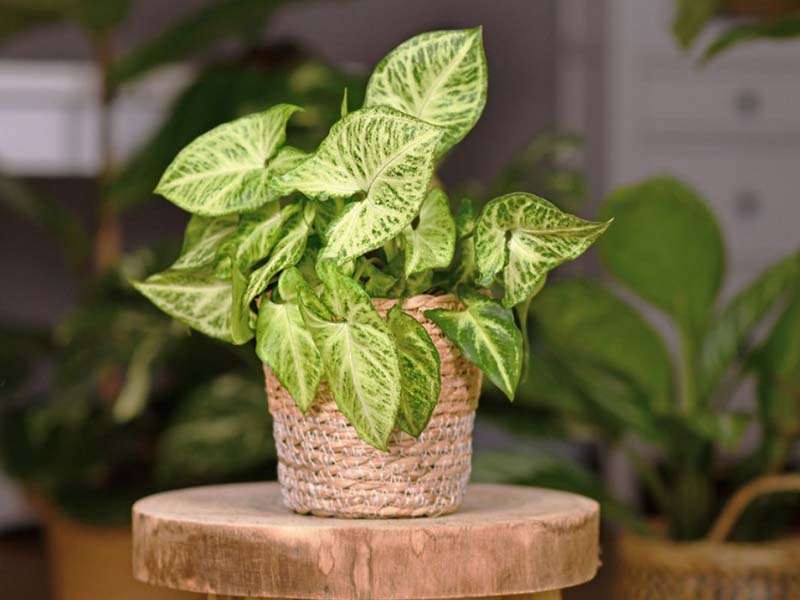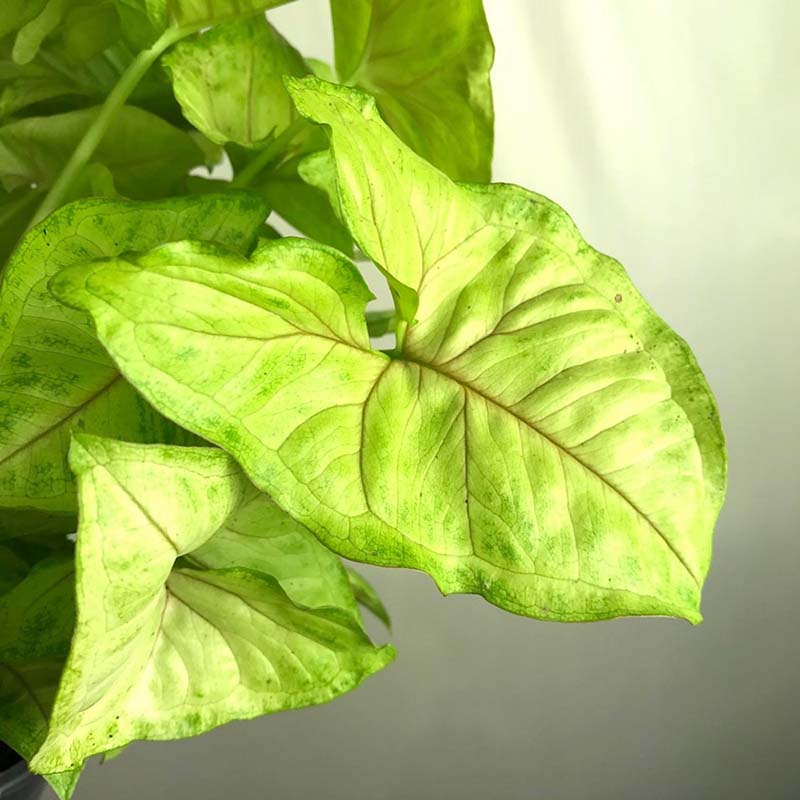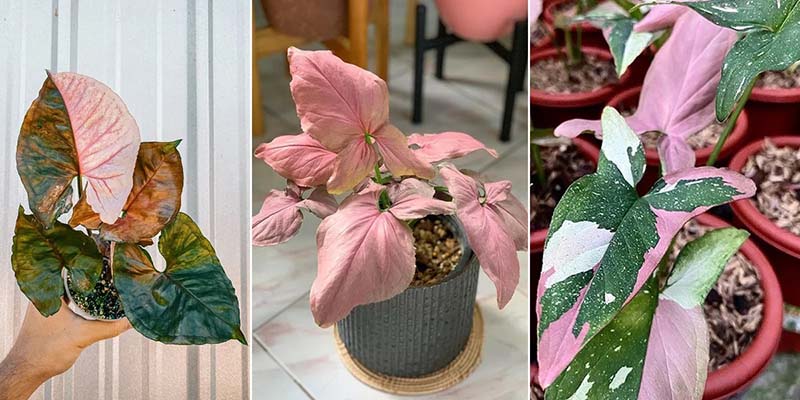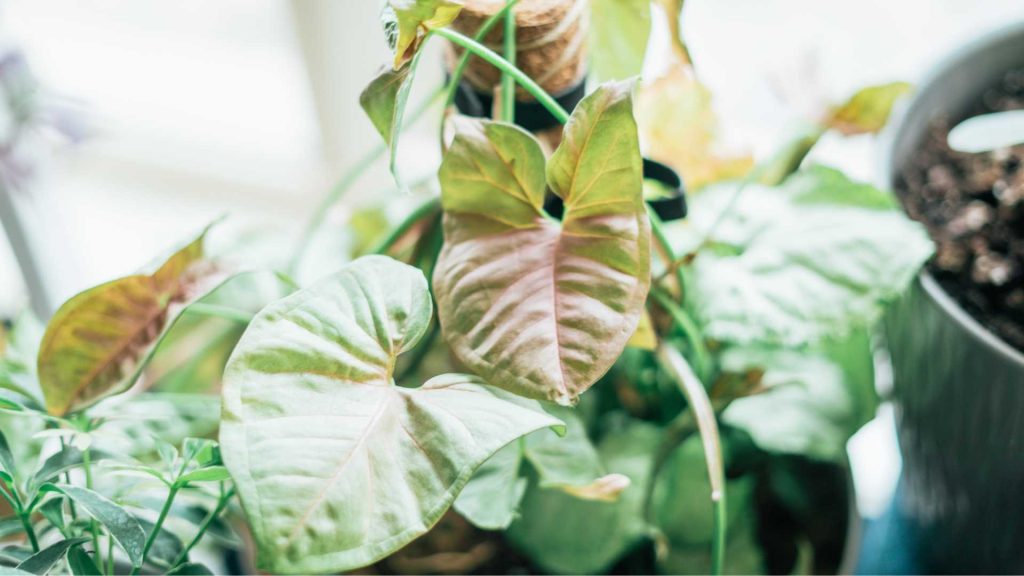The Syngonium plant is representative of the Aroid family, a plant with arrow-shaped leaves. This genus is a climbing vine that is held on supports with the help of roots. The leaf is shaped like an arrowhead. They live in Brazil and other South American countries, as well as in Central America. Syngonium is relatively unpretentious, therefore it is quite widespread in indoor Floriculture. At home, it is grown as a plant or as a liana. Depending on the age and variety, the leaves can be like a green arrowhead, which is most often found, pink and golden arrowhead. A pink arrowhead plant is a great option if you’re looking for an unusual indoor plant.
Syngonium has a fast growth rate. Over a year, arrowhead vines can lengthen by about 100 foot, forming about 6-7 fresh leaf blades. The size of adult specimens is rather large – about a meter. Under natural conditions, the length of vines can reach 65 foot. Now we will tell what arrowhead plant care should be.
How to Care for Syngonium?

Lighting
What lighting is important for an arrowhead plant? Syngonium foliage reacts poorly to direct rays, so the bushes should be kept in partial shade. From the sun’s rays, monophonic foliage can begin to fade and lose its attractiveness. The exception is the variegated arrowhead plant – they require more light, so they can tolerate well and a more sunny location.
Temperature
The temperature regime for Syngonium is quite important. In a too-cold room, the bush will not be able to develop normally and may begin to shed leaves. The room temperature should not drop below 59 °F. The plant does not like sudden changes, it should be protected from drafts. In summer, the vine prefers moderate heat – up to 68-77 °F. In winter, the room can be a little cooler – about 62-64°F, but such a decrease in degrees is not considered mandatory.
Watering
Syngonium bushes need abundant watering, but they should be carried out so that the liquid does not stagnate in the soil – as the soil dries out. For example, in summer arrowhead plants can be watered about a couple of times a week, in winter – no more than once or twice a week. Otherwise, the roots of the plant may start to rot. For irrigation, use moderately warm and well-settled water.
Humidity Level
The plant needs an average moisture level of at least 60%. The leaves are systematically sprayed using lukewarm water. It is especially important to carry out such humidification in hot and dry weather, as well as in winter if the flower is located near a heat source.
The soil
Loose and light substrates are suitable for growing Syngonium. You can use ready-made store mixes for indoor species with a weakly acidic or neutral reaction. To prepare the substrate yourself, you can take a mixture of sand with turf and peat and add leafy soil to it. Bone meals can be added as fertilizer.
Top Dressing
Lack of nutrients can adversely affect the decorative effect of the bush. Its foliage will begin to fade, and sometimes become covered with brownish specks. Syngonium should be fertilized only during the period of its active growth – from spring to late autumn. Topdressing is applied about 2-3 times a month. Usually, complex formulations that practically do not contain calcium are used for this. In winter, the bushes are not fertilized.
Pruning
Thanks to the correct pruning of the Syngonium, you can not only make the crown of the bush neater but also stimulate the growth of fresh shoots. A sharp tool is used for trimming. The branches are shortened at the level of 6-8 leaves. In addition, old branches that interfere with the growth of young growth are also subject to removal.
When pruning, it must be remembered that Syngonium juice may cause skin irritation, therefore, all manipulations with the flower must be carried out with gloves.
Variety of Plants

In nature, there are about 33 varieties of Syngonium. The main differences between them are in the color and shape of the leaves. These plants are not among the flowering plants – all the decorativeness of the vines is provided by their unusual foliage. Sometimes on the bushes, cob inflorescences can appear, but in appearance, they are rather inconspicuous. In this case, the fruits of some species of Syngonium in the homeland of plants is considered edible. The sap of the plant is considered poisonous.
Syngonium Podophyllum
The foliage color of this species can be either light green or variegated. Syngonium podophyllum has heart-shaped leaf plates made of fused lobes. Their length is from 2 to 5 in.
The most popular varieties of this type:
- White butterfly plant– bushes of this variety have unusual, almost white foliage. Because of this feature, such plants need a lot of light especially.
- Gold Allusion at first glance looks very similar to Butterfly Allusion, but unlike it, Gold Allusion has light green leaves, while Butterfly has green leaves.
- Infra Red – varietal hybrid, the color of the leaves of which changes as the bush grows. Young leaf blades are pinkish. As they develop, they turn green but still retain a slight pink shade.
- Spear Point – this variety has foliage decorated with contrasting white stripes. The plant has an arrowleaf and is narrower than other Signoniums.
- Syngonium “Neon pink” – the color of large leaves from white to pale pink. Care for pink Syngonium does not differ much from basic care rules.
- Maria arrowhead plant – unlike the previous varieties, the leaf is rounded, young leaves are red-brown.
- Berry allusion arrowhead plant – has leaves of a light green color, with cream and pink shade.
- Pink allusion arrowhead plant – this variety of pink Syngonium podophyllum has shiny green leaves with red and pink colors and pink veins.
Syngonium Auritum
Its foliage has the shape of an arrow, while in the upper part of the plate there are peculiar “ears”. The foliage of an adult specimen can have 3 to 5 segments. In variegated species, the pattern becomes brighter over time. The bush forms rather long shoots, their annual growth can reach up to 3 foot.
Diseases and Pests

Due to mistakes in care or non-observance of the conditions necessary for the plant, the Syngonium can weaken or get sick. In order not to start the problem and, as a result, not to lose the plant, you need to pay attention to the signals that it gives:
- Leaves of variegated forms began to fade – the bushes do not have enough light.
- Yellowing of foliage is usually caused by a lack of nutrients, poor soil, or excessive lighting.
- Fresh leaves become shallow due to lack of light or nutrition.
- Brown specks on the leaves are associated with insufficient air humidity. Such a bush needs to be regularly sprayed or try to increase the humidity in other ways.
- Droplets on Syngonium foliage are a sign of excessive air or soil moisture. Thus, the plant removes excess water.
- Decay of stems – a consequence of too frequent watering. In this case, the soil does not have time to dry out. The irrigation regime needs to be reviewed. Rot especially often appears with frequent watering in a cool room.
Syngonium can be affected by many pests of indoor plants. If insects appear on the bush, it is treated with insecticidal preparations. Sometimes, as part of the struggle, the bush has to be transplanted into fresh soil, after having washed the roots in a solution of potassium permanganate.


